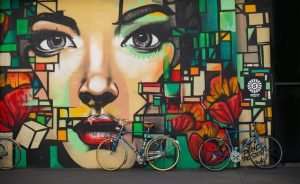I’ve been told by a lot of people that my blog is somehow “problematic” because I promote cute art. I’m not a fan of the term “problematic” because it’s used to describe anything that challenges the status quo, which is most things. But in this context: dear people who tell me my blog is problematic, what are you even talking about?
You’re probably talking about two things. One is gender essentialism, and the other is empowerment through violence.
But first let’s talk about gender essentialism. A few years ago I wrote this post on cute art, and one of the things it said was that cute artwork tends to be female*. This was based on my observation that there are a whole lot more cutesy anime girls than there are cutesy manga boys. And then someone left a comment saying something like, “Well obviously women are more nurturing and you can see that in their artwork.” And I wanted to respond like, “If women were naturally nurturing they would have invented agriculture! And they didn’t – so clearly they’re not all that nurturing.”
But that would have been mean, so instead I just posted a follow-up post called In Defense of Cute where I tried to explain why cute art
When I was in my early teens, I was into anime, which is Japanese animation. I had a lot of posters on my walls, and one day my mom saw them and asked me if I knew that the women in the posters were drawn to be sex objects. I thought about it for a minute and then said yes. My mom looked surprised, like she didn’t think I knew what sex was yet (which was ridiculous), but then she told me that it might be a good idea to take the posters down anyway.
I didn’t really understand why at the time, but as an adult feminist it makes perfect sense to me. Cute art is empowering. There are a lot of things out there that are not cute: rape jokes, racism, misogyny, etc. The world is not a normalizing place for women and girls, so we need all the help we can get.
Trying to make cute art is difficult. It puts you in direct opposition with mainstream culture; cute art has to say no to a lot of what is around us all the time in order to affirm itself as something different and good and important. And cute art requires an audience willing to seek out something different and good and important.*
I am sure you’ve all seen the type of art I am talking about.
It is cute, and it is an art form that many people believe only girls enjoy.
But what if I told you that this type of art is empowering to feminists?
Cute art can be empowering because of three main reasons.
The first reason is the meaning behind cute art. It often represents strong female characters or shows a girl doing something boys would do.
The second reason is that cute art can bring people together. Many girls make these things, so they understand each other and don’t need to explain things in order to have fun together. This creates an environment where a girl can be herself without being judged by others around her.
The third reason why cute art is empowering is because it gives girls confidence in themselves and their abilities. When they draw a good picture, they feel proud of themselves for having drawn something that looks good and was created with love by them.
These are the three main reasons why cute art is empowering for feminists and for other girls who are interested in this kind of thing.”
A lot of people on the internet, especially people who don’t know anything about art, will tell you that cute art is “just” a “feminine” or “girly” thing. They are wrong.
The most obvious problem with this idea is that if “cute” was just a feminine thing, it wouldn’t be in the permanent collection of the Museum of Modern Art. But there’s also another problem: when you think about it, cute art is really empowering for women.
I mean, think about it. If you like cute art, you’re saying that all these cute little animals and dolls and stuff are more interesting than all the other big serious paintings of big important people doing big important things. And that means you’re saying that the lives of those little animals and dolls and stuff are more important than the lives of those big important people. And isn’t that what feminism means?
The feminist movement has been largely co-opted by the “cute” culture. It was a slow process, but now it is everywhere.
Cute things are things that are small, or round, or sweet, or warm, or fuzzy. They appeal to us because they are easy to understand and don’t threaten our sense of security. Cute art is especially subversive because it forces us to see the woman in a way we aren’t used to seeing the female.
Tiny things and infantile things are not threatening, and so in this culture of females as tiny and infantile we have images of women being portrayed as babies and small pets. This works to reinforce the idea that women are cute and harmless, but also that women need men for their protection.
This kind of art is only empowering if you buy into the notion that women should be helpless, tiny creatures who need male intervention in order to survive. This kind of imagery makes female bodies smaller, softer and more infantile and therefore reinforces the notion that we should be taking care of them and not the other way around.
It’s time for us to stop promoting these images as empowering because they aren’t. They’re patronizing and oppressive. And it’s time for us to start believing that
Cute art is a term that refers to a genre of artistic expression in which the subject matter is cute, often in a humorous or satirical way.
Cute art challenges what is considered to be an acceptable subject for art. It can also be seen as an offshoot of postmodern art and as a response to the backlash against feminism.
The term “cute” does not have any specific meaning but has various connotations depending on the context.
The use of the word “cute” in Japanese culture dates back to at least the 17th century, when it was used as an adjective meaning “small”. The word was introduced into English by GIs returning from Japan in the 1950s, who were looking for a way to describe Japanese style (especially manga and anime) that they found appealing and different from American comics and animation. “Cute” was one of several words used to translate the Japanese word kawaii, which originally meant “deformed” or “lame”. Kawaii has become associated with cuteness, but originally it did not have this meaning. Kawaii has been translated as “cute”, although some researchers believe that kawaii more accurately means “loveable” or “desirable”.
The usage of words for
When I was an undergraduate, a professor of art history told me that I would never succeed as a feminist artist because I made things that were too cute. It took me a long time to figure out what was wrong with this statement.
I had grown up in a family where being “cute” was not a compliment. Cuteness was something to be gotten rid of, like baby fat or buck teeth. The cultural politics of cuteness were obvious: it was frivolous, feminine and non-threatening; it relied on forms of expression associated with childhood and femininity for its appeal. Cuteness seemed like the antithesis of everything I wanted to be as an artist.
I’m still not sure if the problem is with cuteness itself or with the way that people tend to use it as a stand-in word for prettiness – which can have a lot more power than cuteness. But neither of these reasons has anything to do with its connection to feminism.
As far as I can tell, when we call something cute, we mean that it is adorable, charming, sweet and appealing in some way. It is wiggly-waggly and soft. A lot of things might be considered cute: kittens, babies, the planet Jupiter and


